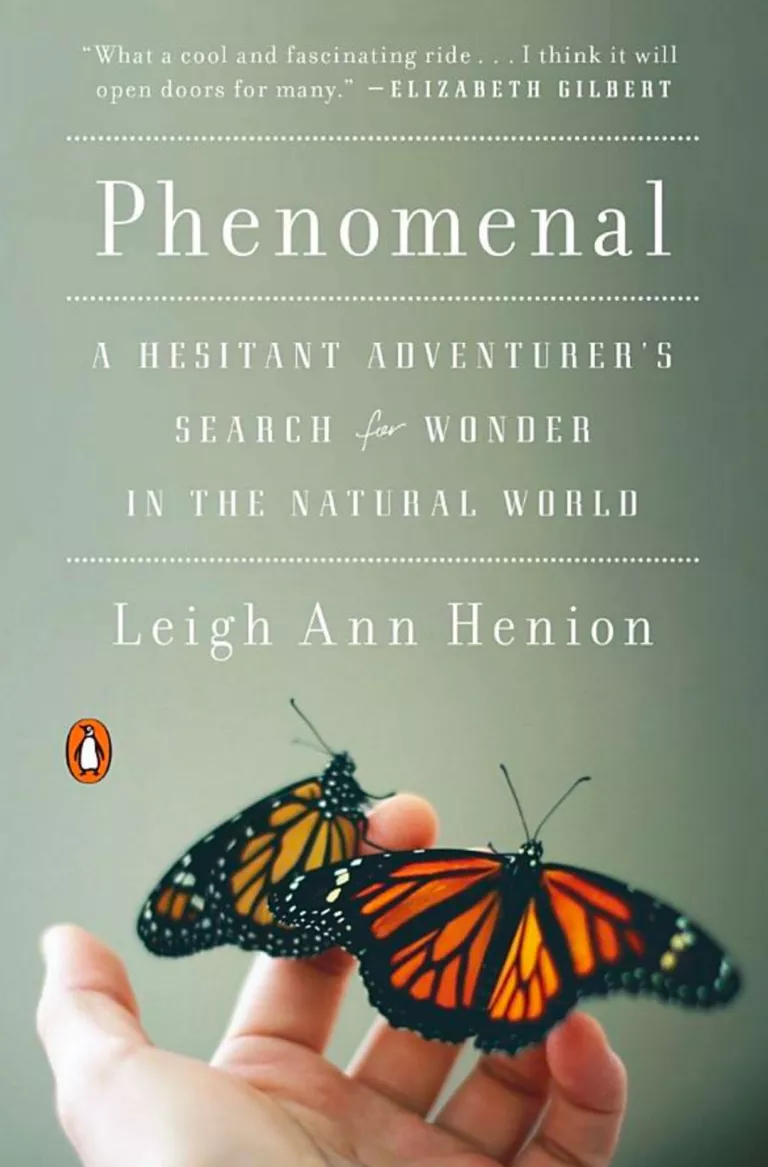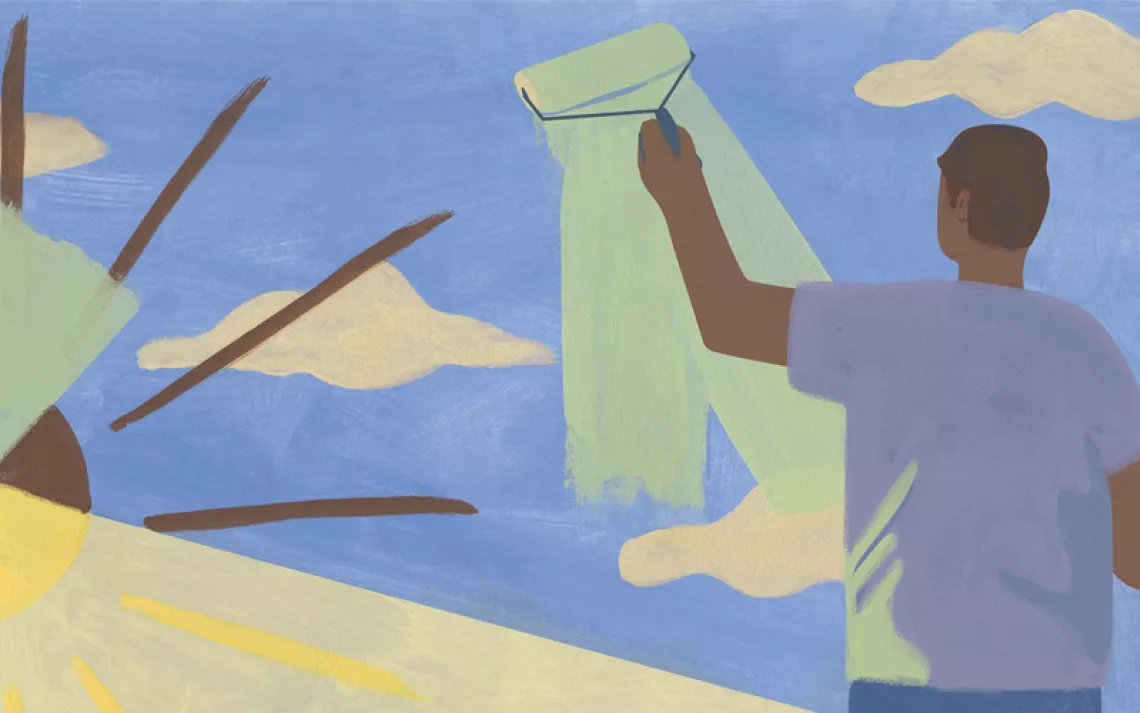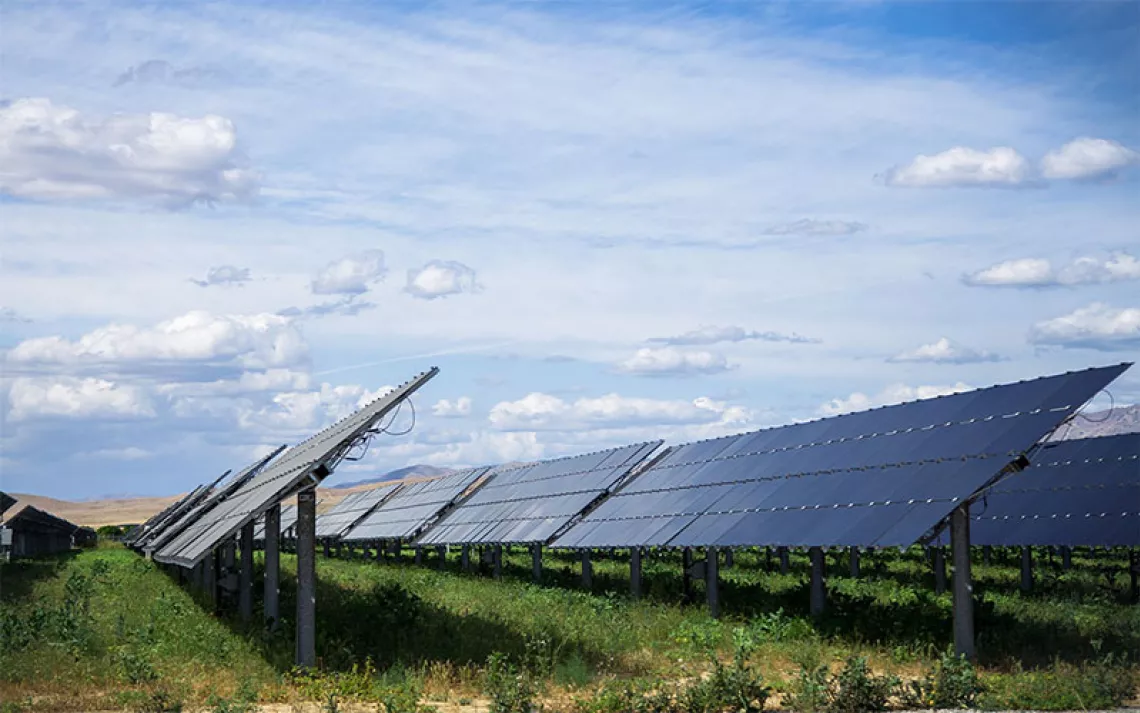A Phenomenal Search for Wonder

Phenomenal: A Hesitant Adventurer's Search for Wonder in the Natural World (Penguin Books, reprint edition 2016)
Leigh Ann Henion had always thrived on exploring new places. Then came motherhood. “Travel to far-flung lands?” she writes in her memoir Phenomenal: A Hesitant Adventurer's Search for Wonder in the Natural World. “Once I had a baby, I considered myself lucky to make it to the grocery store before it was time for bed.” Eventually, though, her new identity leads her on a new kind of journey: “Children have the capacity to marvel over simple things in nature . . . ,” she writes. “Couldn’t exploring just a few of the earth's most dazzling natural phenomena . . . make the world similarly new again, reawakening that sort of wonder within me?” And wouldn’t that, she reflects, ultimately make her a better parent? Thus begins an “epic quest for wonder” that takes her to a bioluminescent bay in Puerto Rico, a lake in Venezuela where lightning storms rage nightly, lava-spewing volcanoes in Hawaii, and other sites where some of nature's most incredible mysteries play out. In this excerpt, Henion witnesses the northern lights above the Arctic Circle.
—Wendy Becktold
When we meet up later that evening in a wood-built, heated dining room, I tell James that as much as I’d like to see the northern lights, I’m also hoping to hear them. Every year, thousands of people report that they’ve heard the aurora. I’ve met nearly half a dozen witnesses myself, all in the space of a few days. What they claim to hear isn’t the impossible-to-make-out waves of infrasound that have been recorded in the aurora at high altitudes. No, they claim to have been witness to the yet-to-be-recorded or scientifically explained, totally audible phenomenon that is the lights’ signature song. There is ancient precedent for this. The Sámi word for the aurora is guovssahs, which roughly translates as “the lights that make noise.”
James is skeptical. “I’ve spent thousands of hours with the aurora and I’ve never heard it before,” he says, temporarily distracted by a young man who’s come into the dining area. James watches as the guy whispers to a group of diners, who rise from their seats. Swedes aren’t known for loud proclamations, and James knows what this might mean. Even when you’re not outside, you have to be on the alert if you want to catch the lights. He gets up and motions me to follow. We’re joined by an increasingly wide stream of people as we rush toward the door. I have never felt more like a stereotypically loud American in my life, but I can’t help but shout to a curious-looking couple as we pass their table: “Northern lights!”
We burst outside to find a crowd already gathered. Above, the aurora is tingling toward the bottom of its arc. The lower sections look like pink fingers dancing across the invisible piano. They extend down in various lengths. Pinky finger. Pointer. The upper stretch of the slender solar storm is somehow more delicate than I’d imagined it to be. It’s a wisp of color. Stars are visible in the background as it slithers and twirls, shrinks and spreads. The arc it traces is, I realize, the curve of the earth. This sky show is revealing the contours of the very planet on which we stand.
James shouts: “Look! Pink! That’s about as good as it gets.” The top of the aurora is glowing green, but the animate bottom of the arch is as pink as Archer’s nose after a day of playing in snow.
“Amazing!” someone shouts from the crowd that’s gathered outside the restaurant’s doors.
“I should get my camera out,” James says, shivering in his fleece vest. In the rush, he couldn’t find his outer jacket, but he knows the aurora doesn’t wait. It can disappear as unexpectedly as it arrives. “This is the best I’ve seen in weeks and weeks,” James tells me, the aurora fluttering like a glowing curtain in a celestial breeze.
The aurora’s tingling pink energy dances, pounding out a visual song. The lamps around the restaurant can’t compete with its power, its undeniable brightness. It is revealing the edge of our atmosphere. We are seeing the visceral meeting of space and earth, the bit of pure sunshine that has slipped through all the protective measure to shine on our faces. It is, in essence, a visual reminder of life’s tentative covenant with the universe. Like Alan said in Venezuela: If the sun changed its temperature, even a little, we’d be toast.
“The sky is bursting into pink flashes—I mean, when does that happen?” James says.
Well, now, for instance. I can’t speak. I’m trying to focus, attempting to let the street lamps and crowds of the ICEHOTEL fall away. But just as I’m beginning to get a feel for the lights, just as I have gathered myself together so that I might be able to think about what I’m seeing—turning to explanations of nitrogen and oxygen instead of standing here, dazzled, in a stupefied gape—the lights disappear. They don’t slip off stage left; no, they twirl themselves into nothingness as spontaneously as they appeared.
I turn to James and exclaim, “I need to see it again!”
He nods and says, “Yeah, that’s it. You get it. Just imagine what it feels like with an eclipse. I’ve got to wait three years to see it again. See, you’re spoiled with the aurora. Maybe it’ll come back for dessert.”
But we end up skipping the restaurant’s sweet treats to wander the shores of the Torne, the best place to view the aurora in Jukkasjärvi, away from the hotel’s lighting. We find a packed trail that will take us to the river. Above, stars flicker, pinpoints on a map.
I’m warm except for my hands, in too-thin gloves because it bothers me to lose dexterity. When I tell James that they’re freezing, he looks a little concerned. “We better head back up,” he says. “There’s no way to know if it’s going to come back tonight, anyway.”
We start to slip-slide across the snow-covered river. I’ve been told that the Torne is beginning to groan, heralding the seasonal melt, but it’s quiet tonight. There’s no crackling from below or above. But suddenly, the sky stirs. Out of nowhere, the aurora appears as a slender branch of light, then it goes mad, all the heavens exploding into groves of green. I see pulsating, swirling, twirling figures drumming as they slip across the sky.
“You’re just batting a thousand here,” James says. “Look, it’s twisting. Whoa!” He ducks a little. “Imagine if you saw that over your apple orchard in Normandy one year and didn’t know what it was!”
The northern lights are not confined to the Arctic. Aristotle wrote of them. Julius Caesar once dispatched troops when he thought the lights were a raging town fire. They’ve been spied as far south as Mexico, pushed by particularly strong solar storms. In 1938, a rare appearance in England made Londoners think Windsor Castle was burning. Aurora drawings appear on the ceiling of the Rouffignac cave in France, where hunters recorded its appearance more than 10,000 years ago. And right now, at this very time, the aurora is taking on the shape of an antler above my head. It breaks into horseshoe-shaped pieces that dance across the sky, prancing like the reindeer of Santa’s sleigh.
It actually might not be coincidence that Santa’s sleigh is pulled by reindeer, the animal Sámi have depended on for thousands of years. Or that the mythological elves of the North Pole wear replicas of traditional Sámi shoes, which are pointed at the tip to fit into skis. Or that this is really as close as humans can get to the North Pole without calling it an expedition. Some anthropologists believe Santa is actually an appropriated version of a Sámi shaman, a noaide, who used drums to navigate between worlds and consumed hallucinogenic red-and-white mushrooms that made them feel as though they could fly. The noaide are said to have been represented on some historic drums as being on a sledge—a small sledge—being pulled through the air by reindeer.
When I looked for books on Sámi mythology and the aurora at the library of a local university before leaving for Sweden, nearly half of what I found was in the children’s section. This seems awfully revealing of how we see the myth. When someone is actively naively, foolishly, we say: You might as well believe in Santa Claus.
Myth and mystery, in a rational age, is something you’re expected to grow out of, though, ironically, we tend to bemoan that loss of magic in the moment Santa’s identity is revealed. We don’t make room for adult-size fables. But some cultures believe we actually get closer to the mystery as we age.
I’ve noticed that the aurora seems to make talking about this sort of spirituality—even outside of established religious traditions—more acceptable than usual. When I announced my plans to see the aurora back home, I had friends—of all religious and nonreligious stripes—tell me that they imagined the aurora as some sort of mystical phenomenon.
The word mystical derives from mystery—from Greek mystes, initiate, and mystos, keeping silent. To have a spiritual experience doesn’t require adopting a system of belief, a code of conduct, theory, or dogma of any sort—traditional or woo-woo. According to William James, mystical or spiritual experiences are—by definition—temporary, impossible to encapsulate in human language, and they transfer some sort of knowledge usually hidden from human understanding to an individual without conscious control.
R. M. Burke referred to them as moments of cosmic consciousness, believing that they were moments of joy and transcendence that brought individuals an enduring sense of order in the universe. Abraham Maslow called them “peak experiences” in an attempt to secularize them. Other researchers, interested in the psychology of spirit, refer to them as transpersonal experiences.
Whatever you want to call them: I’m totally having one.
James is whirling in the snow like a Sufi dervish, mirroring the now-swirling lights above in a ritualistic sort of dance, demonstrating a motion he’s seen lots of people make on nights like this. “A lot of cultures up here believe the lights are the spirits of the dead. It’s about realizing mortality and being initiated into awareness of creation,” James says, staggering to get his balance.
If so, James is more enlightened than most. But it hasn’t come without cost. He tells me that he’s sacrificed a lot for his life of continuous, celestial quest. He does not have a family or permanent home. James follows employment notices to stay within the aurora oval, as the Sámi have followed the natural patterns of reindeer for more than 8,000 years. He lifts a gloved hand to the sky and says, “Human love is important, but cosmic love sustains.”
James nods toward the heavens: “Right now, we’re waking up. This blows the doors off of everything ordinary. It explodes the ego. It’s about the death of ego. Ego death is when you stop thinking about yourself and you realize you’re connected to the entire universe. It’s the us. It’s guys putting rifles down. It’s powerful.”
His voice gains octave. He’s shouting now: “It’s like something out of Lord of the Rings, but it’s real! Real! Epi-phenomena!”
The lights curve into the hook of a J. It’s almost as if they’re writing out letters on a slate too large to see. James smiles and goes quiet. I realize it’s the first time I’ve seen his stony-serious face soften since we met. The dark night washes us in waves of color. We are personally, viscerally, temporarily residing in the living, breathing realm of mythology.
James is shaking his head, as if, even after all these years—after all these magnificent ways the universe has revealed itself to him—he still has difficulty believing such beauty can exist. “It’s a blessing,” he says.
In this moment, we are realizing an experience that is—to tens of thousands of people—an I’ve-got-to-do-this-before-I-die sort of dream. We are standing on a winter-stilled river, being baptized by flowing, glowing streams overhead. Sheepishly, I admit: “Wanting to hear the lights as well as see them just seems greedy, doesn’t it?”
“Yeah,” he says, giving an under-his-breath humph, “that’s what I was actually just thinking. You’re wanting to hear something that’s never been proven to exist. It’s like you’re asking for the impossible!” He’s right. If the aurora is the breath of God, it’s like I’m asking to hear the voice of God, too. Still, there’s a sliver of hope in me, the afterglow of a lingering auroral storm inviting more light. As a totally yogied-out friend of mine recently said to me when I was having one of those pesky who-am-I-to-ask-for-more moments: “You wouldn’t ask for more if you didn’t believe there was more to be had. You have faith in abundance, that’s not a bad thing.”
James concedes, “You know, I do have friends that swear by the sounds. I have a theory that they’re created by electrical discharges.” Many in the scientific community concur. The lights, roughly fifty miles above our heads, are in an area that is believed to have insufficient air to transmit audible sound waves. The varying speeds of light and sound also make this unlikely. Some scientists believe that if there is a physical source of the sound, it can likely be attributed to tiny electrical discharges, a chorus of millions of microscopic lightning bolts firing off of all sorts of earthbound things.
There’s also a theory that purports the noise is all in people’s heads. Not in a you’ve-lost-your-mind way, but as a psychological reaction. Some researchers believe that the electromagnetic field produced during aurora actually has the potential to directly affect the bioelectricity of the human nervous system. Others think it might be an example of the brain mixing signals from the various senses. The sense of sight, if excited by a fast-moving aurora, might somehow be perceived as a sound detected by the ears. In other words, the aurora might be a visceral experience identified before our conscious minds can categorize it. As many a philosopher—and a particularly thoughtful chiropractor friend of mine—has noted: All human knowledge begins with the senses. The brain gets it secondhand.
My fingers are stinging from cold. I ball my hands into fists and pull them into the palms of my gloves, unwilling to move inside. The show isn’t over, but it will likely dissolve as quickly as it came. When it does I somehow feel ill prepared. I hadn’t expected the aurora to show itself so soon. I haven’t had to chase the aurora as I thought I might. I just put myself in its path, and it came to me.
James paces a little, beyond the archway of ice, his work boots squeaking in the snow like rubber-soled sneakers on a basketball court. I can hear the hum of a far-off streetlight, the shatter of day visitors making the way from the hotel’s ice bar, where alcohol is served in ice chalices carved from the river. But the sky isn’t making a sound.
Still, visual whispers of sunlight are slipping into the coldest, darkest hour of night. I will never see these lights again. No one else will ever see exactly what I have seen. Though the lights follow eleven-year cycles of solar activity, there is no way of knowing exactly when or where the phenomenon will appear, or what form it will take.
When the aurora retreats—leaving the winter sky as hardened as it was before that first green sky-sprout began to stir—I have a hard time getting my bearings. James is sympathetic. “The aurora is the manifestation of light where darkness is expected,” he says. “No matter how much you’ve read about it, you’re never really prepared for that.”
 The Magazine of The Sierra Club
The Magazine of The Sierra Club



